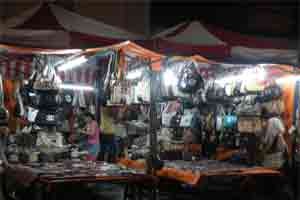Witnessing their children gazing ardently at cartoons produced by foreign picture companies every day on television, a married couple of artists have determined to make animated films not only for educational purposes, but also as entertainment in an admirable effort to help resurrect a dwindling domestic cartoon industry.

Graduated from Dong Nai Province Fine Art School in pottery sculpture in 1984 and later from the Ho Chi Minh City Fine Art University in canvas in 1993, gifted artist Nguyen Hoang Huy, 47, has made his mark in the arts as the winner of several prizes in sculpture and oil paintings awarded by Viet Nam and city’s Fine Arts Association.
Huy married Nguyen Phuong Hoa, 40, a graphic designer, in Dong Nai in 1995. After their marriage, the couple moved to HCMC, where Hoa got a job as an animation artist for a foreign picture company while Huy worked as a volunteer arts teacher for speech and hearing – impaired kids at some centers established by the city’s Red Cross.
In 1996, Huy began work as an animation artist for Glass Egg Digital Media, a foreign-owned game developer and art production company. Through his work, Huy became aware of the current lamentable situation of the animated film industry in Viet Nam.
In recent times, more and more local animation studios have closed down due to high production cost and dwindling demand. Home-made cartoons typically cost about VND150 million (US$9,200) for a 15-minute short, while foreign-made cartoons which have already been shown countless of times in many other countries, but new to Vietnamese kids, flood the local market at only about US$190 per film. Consequently, television stations rarely consider buying new local–made cartoons for their shows.

In 1999, Huy met Mr. Pham Van Chau, an expert animation instructor hired by Glass Egg Digital Media to help further the skills of the artists in the company. Chau told Huy of a team of 30 artists working for the entertainment channel VTV3 of the HCMC–based Vietnam Television to produce cartoons for Vietnamese kids under his leadership, and invited Huy to join the team.
Since Huy and his wife, Hoa, had long nurtured an ambition for Vietnamese kids to watch locally-made cartoons, they jumped at the chance despite the low salaries. But as fate would have it, the team broke up after only four months of work due to lack of funding.
"People may not realise how costly cartoon production can be,” Huy said. “In animated films, long series of individual illustrations are photographed frame by frame, with each frame varying slightly from the one preceding it, thus giving the illusion of movement when the frames are projected in rapid succession at 24 frames per second.
Consequently, cel, or 2-D, animation usually requires the exhaustive effort from large groups of artists working for months or even years on end to produce the frame-by-frame, hand-drawn images used in a full-length feature film."
Disappointed but not disheartened by the dissolution of the team, Huy and Hoa decided to invest their effort into producing five-minute animation illustrating cock and bull stories by the famous French fabulist and poet La Fontaine for SCTV Television.

To keep costs to a minimum, Huy undertook every aspect of production – from writing the scripts, to creating characters, backgrounds, sound and visual effects, to finally directing the films. After this initial success, a series of interesting cartoons named “The Miraculous Pen” then quickly followed.
Together, these short animated films have now been aired regularly on Star Channel of SCTV Television every day. Huy said, “We don’t care about profits, it’s the kids’ enjoyment when watching the cartoons that matters.”
Huy and Hoa are now experimenting on a 15-minute 3-D cartoon named "Chickens and Fox." Huy said, "Generally, 3-D films are cheaper to produce compared to traditional cel films of similar quality and length.
In 3-D films, to create a movement, an artist only needs supply the first and last frames depicting the movement and the computer automatically generates the necessary transitional frames in between, hence the amount of manual labour is greatly reduced and production cost goes down accordingly."
The main constraint the couple currently faces in 3-D animation is the lack of computing power. A higher degree of realism in the characters and backgrounds usually translates exponentially into a larger amount of data that must be generated, and a correspondingly huge increase in computing power and time required.
"With the limited capacity afforded by our dated computer system, we can only make short 3-D films depicting simple characters on sparse backgrounds,” Huy said. “To give an idea of the time an effort involved, it would take our computer about an hour to render one frame depicting a simple character covered in clothes with very little or no fine detailing such as hair and lashes.”

“And compare this with a few seconds it takes for a modern animation studio such as Pixar to produce an even more detailed frame with its powerful computer system,” added Huy. “One can thus appreciate the tremendous amount of time and effort required of us to make even such a short and simple 3-D film."
The production cost of "Chickens and Fox" is over VND100 million (US$6,100). To many, the couple is making a disastrous business investment as until now they still do not know if any television station will buy their product.
“We simply wish to prove that we local cartoon artists have the necessary skills and talents to make animated films that are as interesting and entertaining as foreign shows if we have enough money and are given access to modern technologies,” Huy reasoned.
Huy cited the achievements of the national cartoon industry 20 years ago marked by the successful animated feature “A Just Punishment for the Fox” in 1960. Many cartoons produced after, said Huy, also won golden and silver awards at international and local film festivals, with one stand-out example being the film “The Tale of St. Giong” which won a Golden Dove Award in the International Festival Film in Leipzig in 1970.
"Vietnamese children have a great appetite for cartoons," said Hoa, “What happens if they watch foreign-made cartoons whose stories and characters are often inappropriate to Vietnamese culture and traditions day after day, not to mention the high violent content often seen in many of them?
That’s why we are trying our best to make Vietnamese cartoons for Vietnamese kids, even when there’s little financial reward in return.”
























